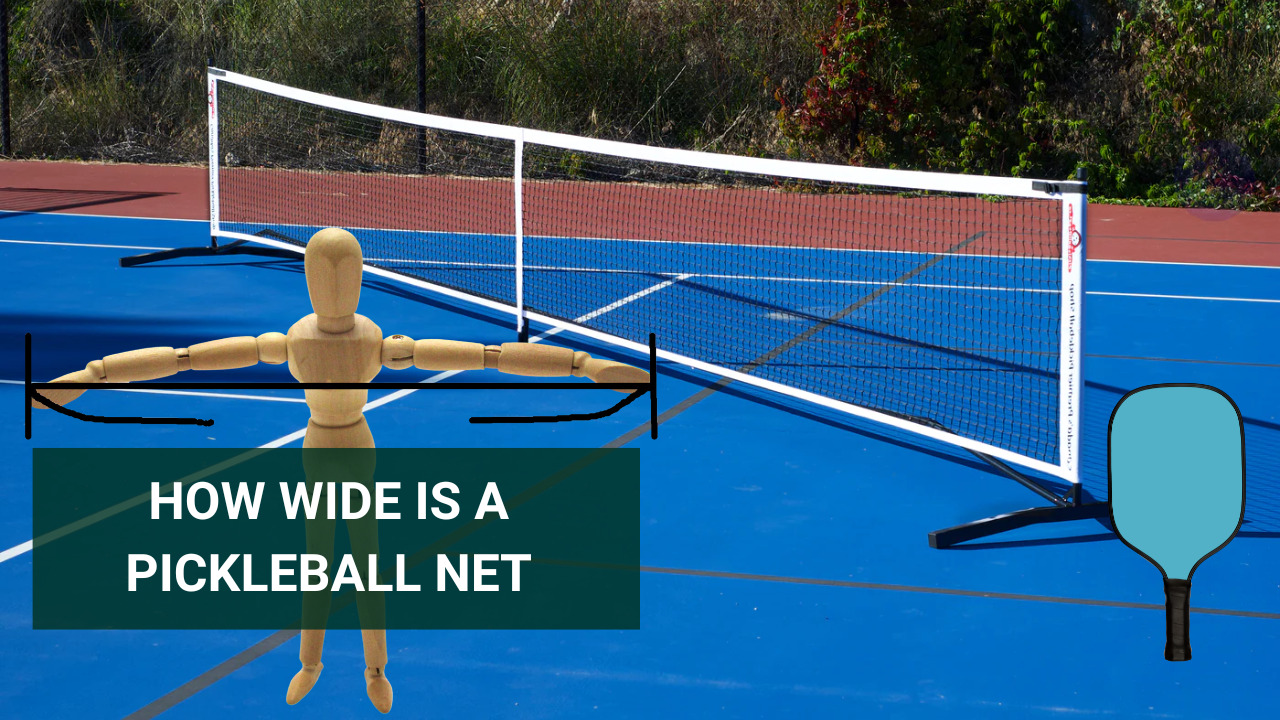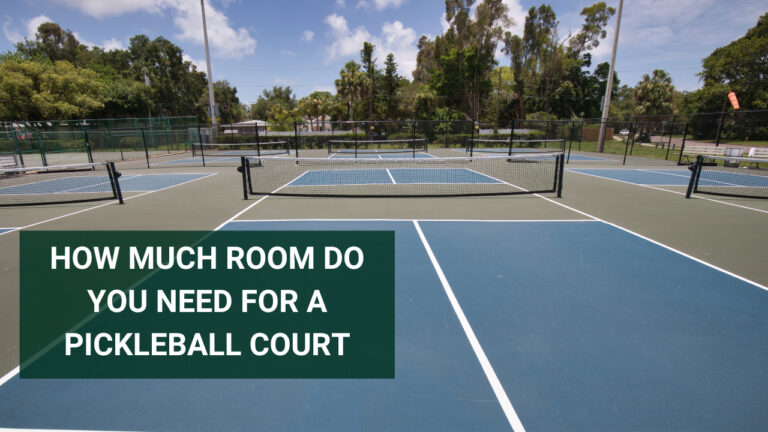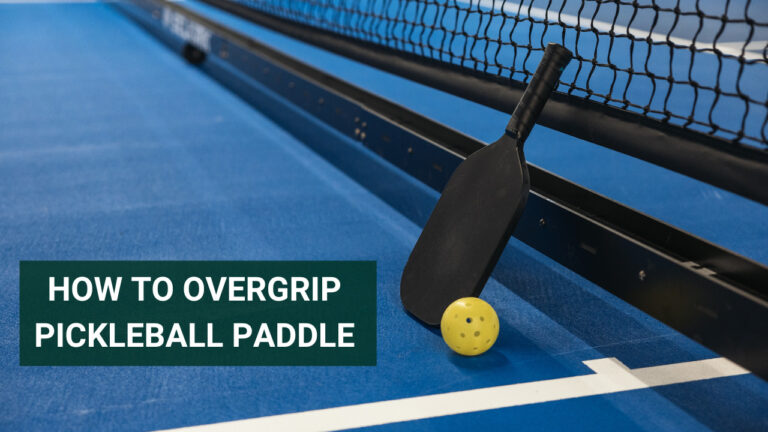How Wide Is A Pickleball Net – Your Go-To Guide
Alright, let’s tackle one of the fundamentals of pickleball – the width of the net. Picture this: You’re on a sunny pickleball court, paddles in hand, ready to take on your opponent. But wait, how wide is a pickleball net you’re aiming to hit the ball over?
The width of a pickleball net is about 22 feet (or approximately 6.7 meters). It’s the sweet spot where fast-paced rallies and exciting gameplay happen – just the right width for some smashing fun!
We have all the juicy details for you. Whether you’re an aspiring player or an avid fan wanting to learn more about this key element of the game, stick around as we explore everything from standard measurements to different types of nets and even regulations.
How Wide Is A Pickleball Net – A Guide
Understanding the pickleball net width is key to enjoying this exciting sport. Let’s break it down.
1. The Official Net Width
- So, here’s the deal: the official width of a pickleball net is 22 feet (or about 6.7 meters).
- This specific measurement isn’t just random; it’s all about making sure the game is fair and exciting.
- USA Pickleball and the International Federation of Pickleball (IFP) set these rules to keep things consistent, especially in tournaments and competitive matches.
2. Measuring That Width
- Now, let’s get into the nitty-gritty of measuring that width.
- It’s the distance between those two vertical posts at each end of the net.
- To keep things on the up and up, you should use pickleball-specific gear like measuring tapes or sticks. No guesswork here!
3. Why Does It Even Matter?
- You might wonder why we’re so obsessed with getting the width just right.
- Well, precise measurements mean everyone has an equal shot at winning, and it keeps the action fast-paced.
- Plus, it’s all about helping players improve their skills, which is what makes pickleball such a blast to play.
Remember, measuring it accurately keeps things fair and fun. So, next time you’re on the pickleball court, you’ll know just how wide that net should be.
Official Pickleball Regulations
Pickleball is a sport that follows specific regulations to ensure fair play and consistency across all levels of competition.
Official pickleball rules govern various aspects of the game, including net height and width.
- Standard Pickleball Net Width
When it comes to the width of a pickleball net, there are specific dimensions outlined by governing bodies such as the International Federation of Pickleball (IFP) and the USA Pickleball Association (USAPA).
These dimensions ensure uniformity in gameplay and provide players with a consistent experience on different courts.
- Measurement Protocol
The width of the net refers to the distance between the two vertical posts located at each end of the net.
To ensure accuracy in measuring the net width, players and officials must use designated pickleball equipment, such as measuring tapes or sticks, specifically calibrated for this purpose.
- Possible Changes in Net Width
Occasionally, there may be discussions within the pickleball community or among governing bodies about modifying the net width. These discussions could be driven by various factors, including:
- Experimental Play: Some venues or clubs might experiment with different net widths for specific events or non-competitive play to explore how they affect gameplay and strategy.
- Adaptations for Special Needs: In certain cases, adjustments to the net width may be considered to accommodate players with disabilities, providing them with a more inclusive pickleball experience.
- Evolution of the Sport: As pickleball continues to grow and evolve, changes in equipment and court dimensions might be proposed to keep the sport challenging and engaging.
- Decision-Making Process
Any proposed changes to the standard pickleball net width must undergo a careful evaluation and decision-making process. Governing bodies, in consultation with players and experts, will assess the potential impact of altering the net width on gameplay, fairness, and safety.
Changes, if deemed necessary, will be communicated to the pickleball community through official channels, such as rulebooks and announcements.
- Adherence to Official Regulations
Until any changes are officially adopted, it is crucial for all players, tournament organizers, and enthusiasts to strictly adhere to the established standard net width of 22 feet (6.7 meters).Maintaining consistency in net width ensures that pickleball remains a fair, enjoyable, and competitive sport for all.
Any potential changes to net width should be carefully considered and communicated through official channels to ensure the continued growth and fairness of the sport.
Variations In Pickleball Net Width
In informal pickleball play, flexibility in net width is common, allowing players to tailor the game to their liking.
| Aspect | Details |
| Non-Standard Net Widths in Casual Play | Flexibility in informal games allows for non-standard net widths. Player preferences may lead to variations in net width. |
| Factors Influencing Adaptations | Skill levels can influence the choice of net width, with narrower nets providing more challenge. Court limitations sometimes require adjustments in net width. Personal preferences play a significant role in determining net width. |
| Custom Pickleball Nets | Custom pickleball nets offer opportunities for tailoring net width and other features to specific needs.Customization can enhance gameplay and overall enjoyment. |
| Variety in Play Styles | Narrower nets tend to favor precision and create challenging shots. Wider nets enable more aggressive and powerful play. |
| Unique Game Experiences | Adaptable informal play with varied net widths makes each game distinct. Customized nets elevate the playing experience by catering to individual preferences. |
This table summarizes how variations in pickleball net width can add diversity and adaptability to the game.
Whether it’s informal play with non-standard widths or the customization of pickleball nets, these variations enhance the pickleball experience by accommodating different playing styles and preferences.
The Different Types Of Pickleball Nets
When it comes to pickleball nets, there are a few different types that you can choose from. Here are some of the most common options:
1. Portable Nets: These nets are lightweight and easy to set up, making them perfect for players who want to take their game on the go. Portable nets typically have a metal frame with a nylon or mesh net.
2. Permanent Nets: If you have a dedicated pickleball court or play regularly at a specific location, a permanent net might be the right choice for you. These nets are more durable and often have steel frames with heavy-duty netting.
3. Adjustable Nets: As the name suggests, adjustable nets allow you to easily change the height of the net based on your preferences or regulation requirements.
4. Tournament-Grade Nets: For serious players or those participating in tournaments, tournament-grade nets offer high-quality construction and meet all official regulations.
No matter which type of net you choose, it’s important to ensure that it meets the standard width for pickleball courts – approximately 20 feet wide.
Conclusion
Understanding the width of a pickleball net is essential for anyone looking to play this popular sport. To accurately measure the width of a pickleball net, various equipment can be used. A tape measure or ruler can help determine if the net meets regulation requirements or needs adjustment.
Knowing how wide a pickleball net should be is vital for maintaining fairness and enjoyment on the court. By adhering to standard measurements and regulations, players can ensure consistent play no matter where they compete.
FAQs
Why do they call the game pickleball?
Pickleball was named after the family dog, “Pickles,” who would chase after the ball and run off with it during the game, leading to the sport’s whimsical name.
What sport is pickleball similar to?
Pickleball is similar to tennis and badminton, combining elements of both sports in a unique and accessible way.
What is a pickleball racket called?
A pickleball racket is commonly referred to as a “paddle.”
What is the average age of a pickleball player?
The average age of a pickleball player is typically in the range of 50 to 65 years old, but players of all ages enjoy the sport.






